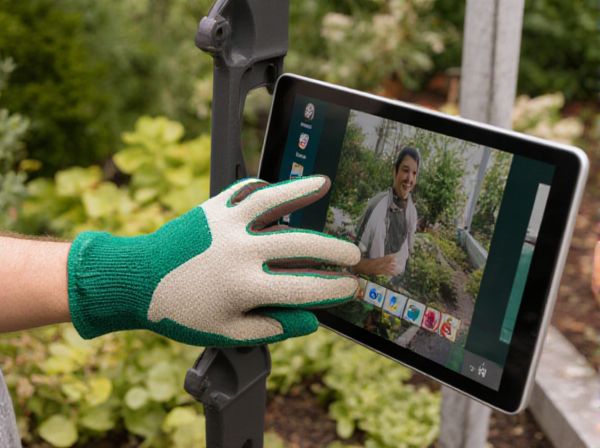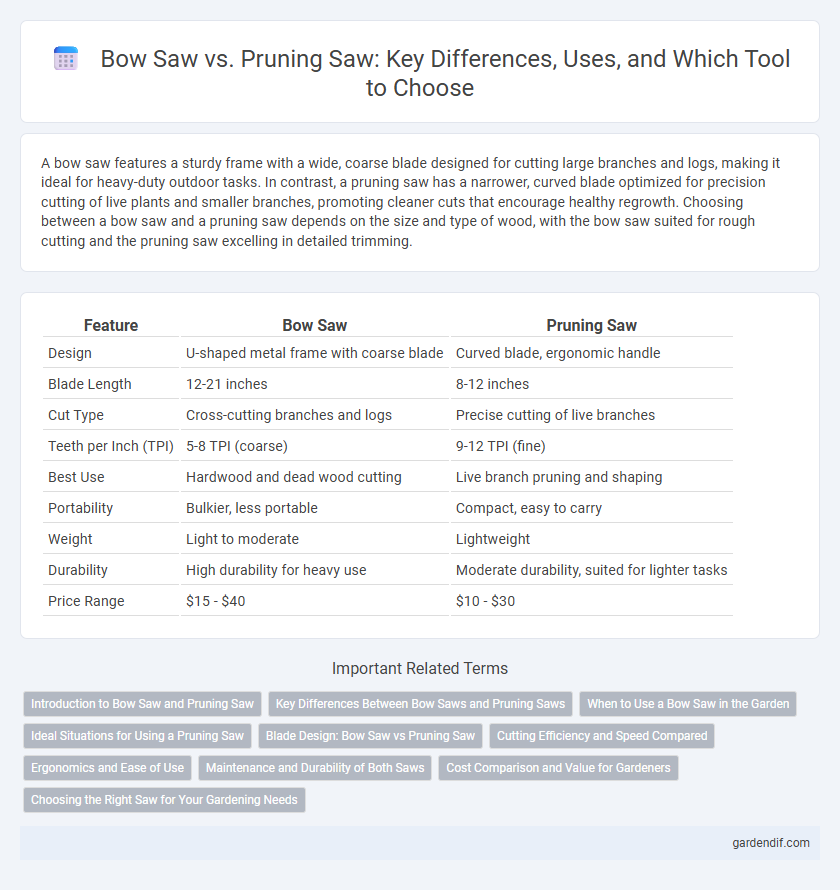
Bow saw vs Pruning saw Illustration
A bow saw features a sturdy frame with a wide, coarse blade designed for cutting large branches and logs, making it ideal for heavy-duty outdoor tasks. In contrast, a pruning saw has a narrower, curved blade optimized for precision cutting of live plants and smaller branches, promoting cleaner cuts that encourage healthy regrowth. Choosing between a bow saw and a pruning saw depends on the size and type of wood, with the bow saw suited for rough cutting and the pruning saw excelling in detailed trimming.
Table of Comparison
| Feature | Bow Saw | Pruning Saw |
|---|---|---|
| Design | U-shaped metal frame with coarse blade | Curved blade, ergonomic handle |
| Blade Length | 12-21 inches | 8-12 inches |
| Cut Type | Cross-cutting branches and logs | Precise cutting of live branches |
| Teeth per Inch (TPI) | 5-8 TPI (coarse) | 9-12 TPI (fine) |
| Best Use | Hardwood and dead wood cutting | Live branch pruning and shaping |
| Portability | Bulkier, less portable | Compact, easy to carry |
| Weight | Light to moderate | Lightweight |
| Durability | High durability for heavy use | Moderate durability, suited for lighter tasks |
| Price Range | $15 - $40 | $10 - $30 |
Introduction to Bow Saw and Pruning Saw
Bow saws feature a thin, curved blade held in tension by a metal frame, designed primarily for cutting green wood and branches, offering efficient crosscutting with minimal effort. Pruning saws have a narrower, straighter blade with fine, sharp teeth optimized for precise trimming and shaping of live plants and shrubs, enabling clean cuts that promote healthy regrowth. Both tools serve distinct purposes in gardening and woodworking, with bow saws suited for larger branches and pruning saws ideal for detailed horticultural maintenance.
Key Differences Between Bow Saws and Pruning Saws
Bow saws feature a large, narrow blade stretched on a metal frame, ideal for cutting through green wood and branches quickly with its coarse teeth and tensioned blade preventing flex. Pruning saws have a shorter, curved blade with finer teeth designed for precise, clean cuts on live branches, reducing damage to the plant and promoting faster healing. The primary difference lies in the bow saw's capacity for heavy-duty cutting and the pruning saw's specialization in delicate trimming tasks.
When to Use a Bow Saw in the Garden
A bow saw is ideal for cutting through thick, green wood and larger branches typically found in garden maintenance, offering aggressive tooth design for fast and efficient cuts. Use a bow saw when dealing with fallen branches, trimming hedges, or preparing firewood, where precision pruning is less critical than speed and power. Its curved blade and sturdy frame allow for smoother sawing motion on robust plant material compared to the finer cuts of a pruning saw.
Ideal Situations for Using a Pruning Saw
A pruning saw is ideal for precise cuts on live branches measuring up to 6 inches in diameter, especially in tight or awkward spaces where larger saws cannot maneuver effectively. Its narrow, curved blade allows for smooth cutting through green wood without crushing the bark, promoting faster healing in plants. This tool excels in detailed garden maintenance, such as shaping shrubs and removing small to medium-sized branches.
Blade Design: Bow Saw vs Pruning Saw
The bow saw features a long, narrow blade with coarse teeth designed to cut through thicker branches and hardwood efficiently, utilizing tensioned blades within a curved frame for stability and leverage. In contrast, the pruning saw has a shorter, rigid blade with finer teeth optimized for precision cuts on live plants and smaller branches, minimizing damage to the plant tissue. Blade material and tooth configuration in bow saws focus on durability and aggressive cutting, while pruning saw blades emphasize sharpness and smooth slicing for healthier pruning results.
Cutting Efficiency and Speed Compared
A bow saw offers superior cutting efficiency and speed for larger branches and logs due to its long, coarse teeth designed to remove material quickly with every stroke. In contrast, a pruning saw features finer teeth that provide more precise cuts but remove material more slowly, making it ideal for smaller limbs and delicate pruning tasks. Choosing between them depends on the task size, where the bow saw excels in rapid cutting of thick wood, and the pruning saw ensures cleaner cuts on thinner branches.
Ergonomics and Ease of Use
Bow saws feature lightweight frames and wide handles, promoting comfortable grips and reducing hand fatigue during extended cutting tasks. Pruning saws typically have curved blades and contoured handles designed for precise cuts in tight spaces, enhancing control and maneuverability. Ergonomically, pruning saws excel in detail work, while bow saws offer ease of use for larger, straight cuts.
Maintenance and Durability of Both Saws
Bow saws feature a tensioned blade system that requires periodic adjustment to maintain optimal cutting performance, while pruning saws often have fixed or foldable blades with minimal tension adjustments needed. Both saws benefit from routine cleaning and blade sharpening to prevent rust and ensure longevity, but pruning saws typically have more durable, rust-resistant blades designed for frequent outdoor use. Proper storage, such as keeping blades dry and covered, significantly prolongs the lifespan of both bow saws and pruning saws under varying environmental conditions.
Cost Comparison and Value for Gardeners
Bow saws typically cost between $20 and $50, offering durability and versatility suitable for cutting thicker branches and small logs, making them a cost-effective choice for multi-purpose outdoor tasks. Pruning saws range from $15 to $40, designed for precision and ease of use in trimming live plants, providing specialized value for gardeners focusing on detailed pruning work. Gardeners seeking budget-friendly options benefit from bow saws' broader applications, while those prioritizing fine pruning might find pruning saws offer better value through enhanced cutting accuracy and maneuverability.
Choosing the Right Saw for Your Gardening Needs
Selecting the right saw for gardening depends on the type of cutting: bow saws excel at heavy-duty tasks like cutting thick branches and logs due to their sturdy frame and coarse teeth, while pruning saws offer precision for managing smaller, live branches with finer teeth designed to minimize damage. Consider blade length and tooth design, as bow saws typically have longer blades (around 21-36 inches) suitable for larger cuts, whereas pruning saws have shorter blades (usually 6-12 inches) optimized for detailed trimming. Matching the saw to your specific gardening tasks improves efficiency and promotes healthier plant growth.
Bow saw vs Pruning saw Infographic

 gardendif.com
gardendif.com